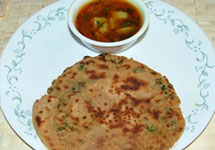Parantha
 A paratha (or parantha) is a flatbread that originated in the Indian subcontinent. It is usually made with whole-wheat flour, pan fried in ghee or cooking oil, and often stuffed with vegetables, especially boiled potatoes, radish or cauliflower and/or paneer (Indian cheese). A paratha (especially a stuffed one) can be eaten simply with a blob of butter spread on top but it is best served with pickles and yoghurt, or thick spicy curries of meat and vegetables. Some people prefer to roll up the paratha into a "pipe" and eat it with tea, often dipping the paratha into the tea.
A paratha (or parantha) is a flatbread that originated in the Indian subcontinent. It is usually made with whole-wheat flour, pan fried in ghee or cooking oil, and often stuffed with vegetables, especially boiled potatoes, radish or cauliflower and/or paneer (Indian cheese). A paratha (especially a stuffed one) can be eaten simply with a blob of butter spread on top but it is best served with pickles and yoghurt, or thick spicy curries of meat and vegetables. Some people prefer to roll up the paratha into a "pipe" and eat it with tea, often dipping the paratha into the tea.
The paratha can either be round, square or triangular. In the former, the stuffing is simply mixed with the kneaded flour and the paratha is prepared like the roti, but in the latter two, the peda (ball of kneaded flour) is flattened into a flattened shape, the stuffing is kept in the middle and the flatbread is now closed around the stuffing like an envelope. The two variants differ in the fact that while the former is like a thick (in terms of width) version of the roti with filling inside; the latter two, have discernible soft layers if one "opens" the crispier shell layers.
The paratha has a social connotation too. The significantly higher expenditure and effort in preparing the paratha when compared with the daily roti means that the paratha is usually prepared as a special item, or for important guests.
The paratha was conceived in ancient North India especially in the region of Punjab. Regardless of its origins, it soon became popular all over India and is now available everywhere in South Asia. Even the South Indian states have their own versions of the ubiquitous paratha, the most popular being "Kerala paratha," also called Kerala porotta.
Indian immigrants took this dish to Malaysia, Mauritius (where it is known as farata) and Singapore, resulting in variations such as roti canai and roti prata. In Myanmar (Burma), where it is known as palata, it is eaten with curries or cooked with either egg or mutton, or as a dessert with white sugar. Htat ta ya, literally 'a hundred layers', is a fried flaky multilayered paratha with either sugar or boiled peas (pè byouk). Paratha in Trinidad and Tobago differs from the South Asian paratha in that it is generally thinner and larger. In Trinidad and Tobago it is commonly called "buss up shut" ("burst-up shirt"), especially by non-Indo-Trinidadians.
Some common types of paratha
Among these common types there are countless variations:
Other pieces of information
The best variety of parathas is served within the state of Punjab, the home of parathas. It is bathed in delicious homemade butter and eaten by dipping pieces of the paratha in homemade yogurt. Parathas go best with lassi, a buttermilk drink also originating in Punjab.
During Ramadan, Muslims from the Indian subcontinent (India, Pakistan, Bangladesh), often eat parathas for breakfast. It is thought that the butter and flour mixture are not only a good souce of calories but also stave off hunger pangs and help sustain a person throughout the long day.
Parathas are commonly eaten with yoghurt or with vegetables. They too are often consumed with meat dishes, especially chicken, but don't particularly sit well with high oil content foods such as curries. Thus it's good advice to remove oil from such foods and eat parathas with the edible pieces from curries, susus and dishes



